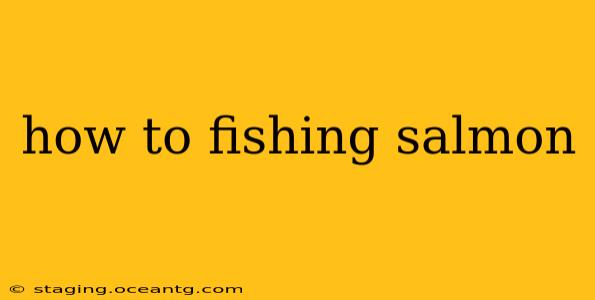Salmon fishing is a thrilling pursuit, demanding skill, patience, and a good understanding of the fish's behavior. Whether you're a seasoned angler or a complete beginner, this guide will equip you with the knowledge to increase your chances of success. We'll cover everything from choosing the right gear to mastering various fishing techniques.
What Type of Salmon Are You Targeting?
Before diving into techniques, it's crucial to identify the species of salmon you're after. Different salmon species have different habitats, behaviors, and preferred lures. Knowing this beforehand significantly improves your chances of a successful fishing trip. Common species include Chinook (King), Coho (Silver), Sockeye (Red), Pink, and Chum salmon. Researching the specific species in your target area is vital.
What is the Best Time of Year to Fish for Salmon?
Timing is everything in salmon fishing. Salmon runs vary by location and species. Generally, spring and fall are popular times, but the precise timeframe depends heavily on geographical location and the specific salmon run. Checking local fishing regulations and reports is essential to determine the optimal time to fish in your area.
What is the Best Bait or Lure for Salmon Fishing?
Choosing the right bait or lure depends largely on the species of salmon, the water conditions, and the time of year. Popular options include:
- Spoons: These versatile lures mimic small baitfish and are effective in various water depths.
- Plugs: These artificial lures, often resembling baitfish, are retrieved with a jerking action to attract salmon.
- Spinners: These lures use a rotating blade to create vibrations and attract fish from a distance.
- Fly fishing: This technique involves using artificial flies to mimic insects or small fish. It's particularly effective in certain rivers and streams.
- Bait: Natural baits like herring, squid, and eggs can be highly effective, especially during certain times of the year.
What are the Different Techniques for Salmon Fishing?
Several techniques are used to successfully catch salmon:
- Trolling: This involves dragging lures or bait behind a moving boat. It's effective for covering large areas of water and locating schools of salmon.
- Casting: This involves throwing lures or bait from the shore or a boat and retrieving them with a specific action to attract salmon.
- Drift fishing: This technique involves letting your bait or lure drift along with the current. It's often effective in rivers and streams.
- Fly fishing (as mentioned above): This method requires specialized gear and skill but can be highly rewarding.
What is the Best Gear for Salmon Fishing?
Choosing the right gear is paramount for a successful fishing trip. You'll need:
- Rod: A sturdy rod capable of handling the weight of your lure or bait and the power of a fighting salmon.
- Reel: A reel with a strong drag system to handle the powerful runs of salmon.
- Line: Strong, braided line is generally preferred for its strength and sensitivity.
- Lures/Bait: As discussed earlier, the best choice depends on various factors.
- Terminal Tackle: This includes hooks, swivels, and weights.
Where is the Best Place to Fish for Salmon?
The best place to fish for salmon varies significantly depending on the species and time of year. Researching local fishing reports and regulations is crucial. Consider factors like water temperature, depth, and currents when selecting your fishing spot.
What are the Regulations for Salmon Fishing?
Salmon fishing is subject to strict regulations that vary by location and species. It's vital to familiarize yourself with the specific rules and regulations in your fishing area before you go. These regulations often include limits on the number of fish you can catch, size restrictions, and specific gear requirements. Failure to comply with these regulations can result in significant penalties.
What are Some Tips for Successful Salmon Fishing?
- Patience is key: Salmon fishing often requires patience and persistence.
- Learn the habits of the salmon in your area: Understanding their behavior and migration patterns will significantly increase your success rate.
- Use quality gear: Investing in good-quality equipment is essential for a safe and enjoyable experience.
- Check weather conditions: Adverse weather conditions can significantly impact fishing success.
- Practice proper fish handling techniques: Ensure the fish is handled carefully to minimize stress and increase survival rates.
By following these tips and understanding the nuances of salmon fishing, you'll significantly improve your chances of landing that trophy fish. Remember to always prioritize safety and respect the environment. Tight lines!
